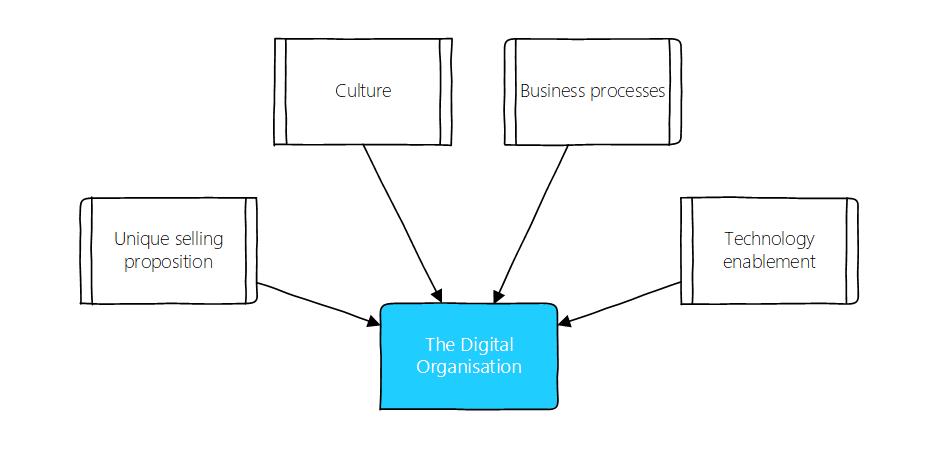DIGITAL TRANSFORMATION
One API does not a Digital Organisation make
(queue pearl-clutching, knee-jerk indignation)
26 NOVEMBER 2020
|
OBSIDIAN INFORMATION TECHNOLOGIES
DIGITAL TRANSFORMATION BUSINESS PROCESS RE-ENGINEERING BPR SOFTWARE DEVELOPMENT INTEGRATION MOBILE SERVICE-ORIENTED ARCHITECTURE BUSINESS PROCESSES PROCESS ENGINEERING
Organisations across the globe are increasingly embarking on Digital Transformation programmes to stay competitive in the corporate version of Keeping up with the Joneses. Leading the pack has become nothing short of a perpetual one-upmanship, but now with a digital twist. When the incumbent leader adds a new feature to their mobile app, the benchwarmers are guaranteed to be following close behind with the same me-too shiny thingy.
However, what many organisations fail to realise is that Digital Transformation goes far beyond APIs, cloud computing, mobile apps and screen scraping mainframe systems older than the CEO. True and proper Digital Transformation (DTx) is a multi-dimensional strategy that should recode the DNA in every cell within your organisation.
First off, allow me to demonstrate what value-adding Digital Transformation should look like.

The ultimate goal of DTx is to create the Digital Organisation. Sure, there are some low-hanging fruit to show your intentions to eventually transform your organisation, for example automating processes, reusing enterprise services in a service-oriented architecture (SOA) or moving enterprise software to Amazon Web Services or Azure. But (and this is a big but) none of these things will provide you with the Digital Organisation. These tactics merely introduce some transactional efficiency or integration capabilities to often largely unchanged technology architectures, and worse, unchanged organisations.
SO HOW DO WE GET TO THE DIGITAL ORGANISATION?
First off, the organisation MUST retain its unique selling proposition. If your key market differentiator is cheap and efficient transactional banking, you should continue exceling in transactional banking. That is your secret sauce and must remain unchanged during the DTx programme, unless you're pivoting into making cheese or wine. In which case, you're probably not looking for the Digital Organisation, but a degree in specialist farming.
So why mention this at all? Glad you asked. What Digital Transformation should help you achieve is to AMPLIFY the organisation's unique selling proposition through a series of different processes, combined with technology to produce the Digital Organisation. The idea is therefore to create a business that can better deliver its core products and services through technological enablement.
The most difficult part of any organisation to change is its culture. Culture consists of shared beliefs and values distilled from the leaders' behaviour and communication. These influences ultimately shape employees' perceptions and behaviour. To be effective in creating the Digital Organisation, a sustained culture change will be required to support the (potentially complete) overhaul of outdated and inefficient business process (or the organisation as a while) and the way people go about their work.
Next up, and probably one of the most overlooked parts, is the re-engineering of bad business processes. This is done through a formal management methodology known as Business Process Re-engineering (or BPR). BPR is a structured process for analysing, organising and redesigning underperforming processes and resource structures around them. So why does this matter? Quite simply because building software for outdated, inefficient and ineffective businesses and business processes is wasteful, counterproductive and akin to paving the cow paths. A bad process simply cannot be fixed by good software, though it is a good way to waste your money.
Good processes are necessary to maximise the value from your information systems. Re-engineered processes should not be defined in terms of software systems, but in terms of improving customer service, product quality or to exploit market opportunities. Business processes and structures ALWAYS precede software systems, as the systems should fit the organisation, not the other way around.
(unclench, release the pearls and stand up straight)
Now that you understand the multidimensional nature of Digital Transformation, it should be clear that this is a much more complex exercise than APIs, cloud computing and Continuous Delivery. Don't get me wrong. All of those things are really important as components of the Digital Organisation and could even individually improve the efficiency of parts of your business. But doing these things without fundamentally re-engineering outdated business processes, structures and culture will only get you so far. And by the time you realise that the organisation is effectively heading into its twilight years, it may be too late to reverse the effects of Analogue Ageing.
NEED HELP?
Through decades of experience in creating technology and supporting similar transformation processes in mining and financial services, we can provide your organisation with the necessary support and guidance to transform your company and even your industry.
Contact us for more information